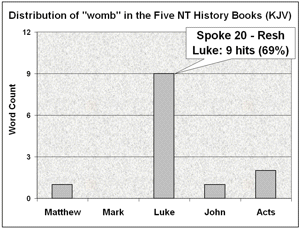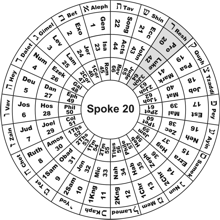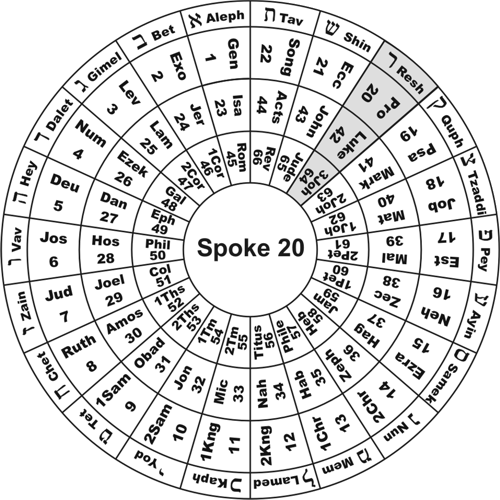Luke: The Gospel of Women
And it came to pass, that, when Elisabeth heard the salutation of Mary,
the babe leaped in her womb; and Elisabeth was filled with the Holy Ghost:
And she spake out
with a loud voice, and said, Blessed art thou among women, and blessed is the fruit of thy womb.
And whence is this to me, that the mother of my Lord should come to me? For, lo,
as soon as the voice of thy salutation sounded in mine ears, the babe leaped in my womb for joy.
Luke 1:41ff (Spoke 20, Cycle 2)
 One of the
most prominent features of the Third Gospel, noted by most commentators, is its inclusion of, and emphasis upon women.
Here is how Geldenhuys (The Gospel of Luke, The New International Commentary on the New Testament, pg. 44)) put it: One of the
most prominent features of the Third Gospel, noted by most commentators, is its inclusion of, and emphasis upon women.
Here is how Geldenhuys (The Gospel of Luke, The New International Commentary on the New Testament, pg. 44)) put it:
In Luke, Jesus is not only the Great Physician, but also the
self-sacrificing Friend who shows friendship towards the
poor as well as the rich, towards the highly honoured as well as towards the despised publicans
and sinners, and even towards fallen women. Especially to Jesus' saving and
uplifting work amongst women an important place is assigned in the Gospel.
In Luke is shown, as nowhere else, what a totally different attitude Jesus
assumed towards women in contrast with the contemptuous attitude which
[was then] manifested towards them.
Luke's sensitivity towards women is such that his whole Book is marked with a distinctly
feminine overtone. His concern for downcast women is particularly evident.
Over half of all references to
widows in the Five New Testament History Books appear in his Gospel.
 Luke's admiration of the faithful amongst them is memorialized in the story of the poor widow's two
mites which Christ counted as worth more than the buckets of excess money the rich men tossed into
the treasury (Luke 21:1).
Luke's concern for,
and interest in women is also seen in the distribution of "womb" – 69% of which are
found in his Book. This is particularly interesting because the Hebrew word רחם (racham (mercy))
also denotes the womb. It is for these reasons and many more that most commentators note
that Luke is known as the Gospel of Women. This also forms a strong link to the
Praise of the Virtuous Woman that closes the Book of Proverbs.
Luke's admiration of the faithful amongst them is memorialized in the story of the poor widow's two
mites which Christ counted as worth more than the buckets of excess money the rich men tossed into
the treasury (Luke 21:1).
Luke's concern for,
and interest in women is also seen in the distribution of "womb" – 69% of which are
found in his Book. This is particularly interesting because the Hebrew word רחם (racham (mercy))
also denotes the womb. It is for these reasons and many more that most commentators note
that Luke is known as the Gospel of Women. This also forms a strong link to the
Praise of the Virtuous Woman that closes the Book of Proverbs.
Comments on the Gospel of Luke by T. D. Bernard
But if he will not hear thee, then take with thee one or two more,
that in the mouth of two or three witnesses every word may be established.
Matthew 18:16
Below are comments from T.D. Bernard as quoted in
The History of the Church of God  by Cushing and Sylverster Hassell. All the hyperlinks point to articles already published on BibleWheel.com that
confirm and amplify Bernard's rather obvious observations. (I say "obvious" not disparagingly, but to remind
the reader yet again that the evidence of the divine design of the Holy
Bible is as plain and obvious as anything could be.):
by Cushing and Sylverster Hassell. All the hyperlinks point to articles already published on BibleWheel.com that
confirm and amplify Bernard's rather obvious observations. (I say "obvious" not disparagingly, but to remind
the reader yet again that the evidence of the divine design of the Holy
Bible is as plain and obvious as anything could be.):
The gospels give us four aspects of Christ, though but one portrait; in Matthew He is,
predominantly, the Royal Lawgiver; in Mark, the Mighty Worker; in Luke, the Friend of man; in John,
the Son of God. Matthew, the Hebrew gospel, is the true commencement of the New Testament; it represents Jesus
as the son of David, the son of Abraham, and continually refers to the fulfillment of the
Old Testament Scriptures. Mark, Peter’s gospel, represents Jesus, as Peter said to Cornelius,
as anointed with the Holy Ghost and power, going about doing good and healing all oppressed with the
devil; it is the gospel of action — rapid, vigorous and vivid.
Luke, Paul’s gospel, presents Jesus, not as the son of Abraham only, but as the son of Adam;
it seems broader in its human sympathy, and is pre-eminently a gospel for the Gentiles — the gospel of the Son of Man,
its key-note being mercy; the gospel for women,
dwelling upon Elizabeth, the Virgin Mary, Anna, Martha and
her sister Mary, and the female disciples who
ministered to Christ and His Apostles; the gospel for children, dwelling upon the birth and youth of
John the Baptist and of Jesus; and the gospel of sacred poetry, the first two chapters being a
paradise of fragrant flowers, where the air is resonant with the
sweet melodies of heavenly gladness
and thanksgiving; the gospel of Luke, says the infidel Renan, is the most beautiful book in the world.
|



